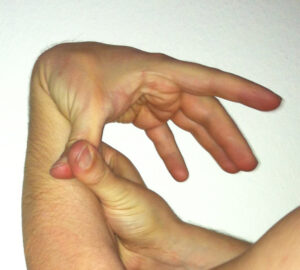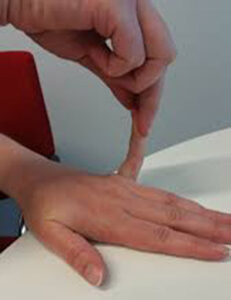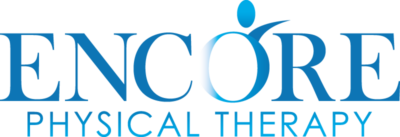Hypermobility syndrome is estimated to affect between 10%-25% of the population, although severity may vary. A disorder that causes the joints to extend beyond the normal range, hypermobility is one variation of a more generalized diagnosis known as Ehlers-Danlos Syndrome. It is often seen in patients that are or have been deeply involved in gymnastics, dance, and other sports where flexibility contributes to the performance of these athletes. When joints hyperextend, it can lead to other issues in the surrounding, and sometimes remote, areas of the body. For example, a hip joint called the sacroiliac (SI) can over-extend causing radiating pain down the leg. In fact, it’s sometimes difficult to evaluate whether pain is originating from the lower back or is the result of a malfunction in another joint, such as the SI. Similarly, other symptoms such as fatigue and gastrointestinal issues could be related to hypermobility issues. So how do you know if you have hypermobility?
First, rate yourself using what is called the Beighton Scale, a well-established indicator of hypermobility. Then evaluate other likely symptoms. Consider the measurements below.

- Touch Thumb to Forearm
This is sometimes referred to as being double-jointed, but in reality it is the ability to stretch the joint past the range available to most individuals. Try pulling your thumb back and down towards your inner arm on each side. Record one point for each thumb that comes into contact with your forearm.
- Hyperextend Your Elbows
To test for this, stretch your arm out straight with your inner elbow facing upwards. Now look down the line of your arm. If the outer elbow bows upwards rather than maintaining the straight line, mark yourself one point for each elbow where this occurs. Note that you may be hypermobile in certain joints and not others.
- Hyperextend Your Knees
Similar to the test for the elbow, examine the range of your knees. If you can push the back of your knee back past the straight line of your leg, mark one point for each knee where this occurs.
- Touch the Floor
 From a standing position, keep your legs straight and bend forward towards the ground. If you can touch the palms of your hands to the ground, mark one point.
From a standing position, keep your legs straight and bend forward towards the ground. If you can touch the palms of your hands to the ground, mark one point.
- Hyperextend Your Pinky Finger
Pull your pinky finger backwards and mark one point for each finger that rotates past 90 degrees.
- Intestinal, Skin, and Other Symptoms
Note that rating high on the Beighton scale is not an exclusive indicator of hypermobility. You must also show other signs of the syndrome. These additional symptoms can include frequent dislocation of joints such as jaw, shoulder, or knee cap, chronic fatigue, chronic muscle and bone pain, some heart conditions, elastic skin, bruising easily, and repeated sprains or rolling of the ankles. Similarly, rating low in the Beighton scale is not a definitive measure that you do not have hypermobility issues. The syndrome may predominantly manifest in different ways.
- Family History
Ehlers-Danlos is believed to be inherited genetically. Some research reports a 50% chance of genetically inheriting the syndrome from a parent with hypermobile EDS.
 Physical Therapy can be very beneficial as a treatment for hypermobility by teaching you how to strengthen the proximal muscles of the spine and larger joints of the body. This process involves identifying and improving the functionality of musculature that has been doing the job for other, weaker muscles and unstable joints. We then help you improve your strength and stability, as well as provide education about proper positioning of the body while you work and perform other daily activities. This will reduce your chances of overloading bodily structures previously at risk of damage from those movements. This, in turn, will make you feel more confident, comfortable, and physically stable, as well as reduce pain associated with hypermobility.
Physical Therapy can be very beneficial as a treatment for hypermobility by teaching you how to strengthen the proximal muscles of the spine and larger joints of the body. This process involves identifying and improving the functionality of musculature that has been doing the job for other, weaker muscles and unstable joints. We then help you improve your strength and stability, as well as provide education about proper positioning of the body while you work and perform other daily activities. This will reduce your chances of overloading bodily structures previously at risk of damage from those movements. This, in turn, will make you feel more confident, comfortable, and physically stable, as well as reduce pain associated with hypermobility.
Hypermobility and Ehlers-Danlos is often overlooked as an underlying cause for other conditions. If you think you may have it, check with your medical professional. Then call for an appointment with Encore Physical Therapy. Through core stabilization and targeted strengthening, we can help you get back in the game.
For More Information:
https://rarediseases.info.nih.gov/diseases/2081/hypermobile-ehlers-danlos-syndrome
